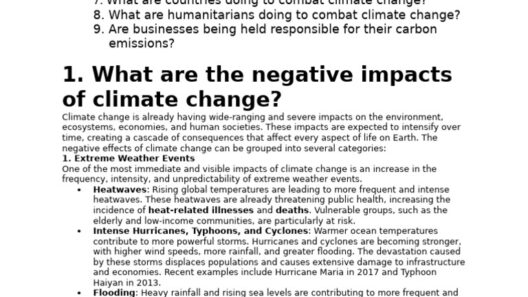Global warming, an undeniable consequence of anthropogenic activities, has spurred a plethora of initiatives aimed at its mitigation. Despite the fervent efforts to ameliorate this pressing crisis, the trajectory of increasing global temperatures reveals a sobering reality: many of these endeavors have faltered. Delving into the multifaceted approaches undertaken by individuals, corporations, and governments provides a clearer understanding of how society is grappling with climate change and the limitations of these mechanisms.
One of the most prevalent strategies for combating global warming is the transition to renewable energy sources. Prominent alternatives such as solar, wind, and hydroelectric power have gained traction in both policy frameworks and public consciousness. Governments around the globe have initiated incentivizing schemes to accelerate the adoption of renewable technologies. However, these measures often encounter significant barriers. For instance, the initial financial outlay associated with infrastructure development, coupled with regulatory complexities, can deter both small-scale and larger investments. Furthermore, the intermittency of renewable energy sources raises reliability concerns, compelling reliance on fossil fuels as a transitional source until sustainable solutions are firmly established.
Reducing carbon emissions through transportation reform is another cornerstone of climate action. The promotion of electric vehicles (EVs) constitutes a crucial element in the endeavor to decarbonize road transport. Numerous countries have set ambitious targets for phasing out internal combustion engine vehicles, while car manufacturers are expanding their EV portfolios. Nonetheless, the proliferation of EVs does not occur in a vacuum. The associated environmental impact of manufacturing batteries, alongside the challenges of charging infrastructure and renewable grid integration, undermines the perceived benefits of electric mobility. An absence of comprehensive policies addressing these intricate facets results in an incomplete approach to mitigating carbon footprints.
Moreover, the preservation and restoration of ecosystems play a vital role in sequestering carbon. Forest rehabilitation projects, wetland restoration, and afforestation initiatives are increasingly recognized for their potential to absorb atmospheric CO2. Yet, these natural solutions often hinge upon local community engagement and policy coherence. Deforestation, driven by agricultural expansion and urbanization, continues unabated in many regions, negating the intended benefits of restoration endeavors. The disconnect between local needs and global climate strategies frequently undermines successful implementation, stressing the necessity of integrating socio-economic considerations into environmental policies.
Furthermore, climate change advocacy and grassroots activism have mobilized millions, amplifying public awareness and spurring action at multiple levels. Movements such as Fridays for Future and Extinction Rebellion exemplify the powerful intersection of youth-driven climate action and political discourse. While their efforts have led to heightened visibility of the climate crisis, they frequently encounter pushback from entrenched interests resistant to change. The political inertia surrounding climate policy often stymies progress, reflecting a disjunction between popular demand and governmental responsiveness. As a result, activists find themselves in a perpetual struggle against systemic obstacles, emphasizing the complexity of enacting substantial climate policy shifts.
Corporate responsibility has also emerged as a focal area of climate action, with numerous businesses pledging to attain net-zero emissions by a designated date. This corporate rhetoric, however, can sometimes obscure a lack of substantive action. Greenwashing, wherein companies market themselves as environmentally friendly without implementing meaningful changes, has proliferated. In many instances, sustainability reports superficially address corporate emissions while neglecting broader supply chain impacts. Investors and consumers increasingly demand accountability; however, the complexity of corporate emissions often renders comprehensive assessment challenging. Thus, despite earnest intentions, many corporate climate initiatives risk being tokenistic rather than transformative.
The global landscape of climate financing further complicates the scenario. Actions to finance adaptation and mitigation efforts in developing countries are essential yet fall short due to inadequate funding mechanisms. Developed nations have historically failed to meet their financial commitments, resulting in a funding gap that hampers climate resilience and sustainability in vulnerable regions. Without concerted financial mobilization, vital adaptation strategies remain underfunded and ineffective, limiting the capability of countries to respond to climate impacts effectively.
Innovations in technology are also anticipated to play a pivotal role in remedying climate change. Carbon capture and storage (CCS), bioengineering, and geoengineering represent promising, albeit controversial, avenues for intervention. However, the unproven efficacy and potential unintended consequences of these technologies fuel skepticism among environmentalists. The over-reliance on technological fixes may obscure necessary systemic changes within societal structures, fostering a detrimental complacency in collective climate action. Moreover, technological solutions must be accompanied by rigorous ethical considerations to prevent exacerbating existing inequalities or undermining ecological integrity.
As individuals, there exists a myriad of options to contribute to climate action, ranging from lifestyle changes to communal initiatives. Conscious consumption, such as reducing meat intake and supporting local economies, exemplifies how personal choices can collectively influence market dynamics. Nevertheless, individual actions alone are insufficient to instigate systemic change. The overarching narrative of climate change necessitates a collective, coordinated response that transcends individual efforts and strips away the notion of personal responsibility as a panacea.
In summation, while diverse strategies have been deployed to combat global warming, significant pitfalls persist. The challenges – ranging from financial barriers to socio-political dynamics and technological dependencies – illustrate that the road to meaningful climate action is fraught with complexity. Creating a cohesive strategy to address the multifarious aspects of climate change is imperative. Success will rely on integrating diverse efforts, fostering collaboration across sectors, and ensuring equity in the pursuit of sustainability. Only through concerted and inclusive action can society hope to navigate the daunting challenges posed by climate change.







